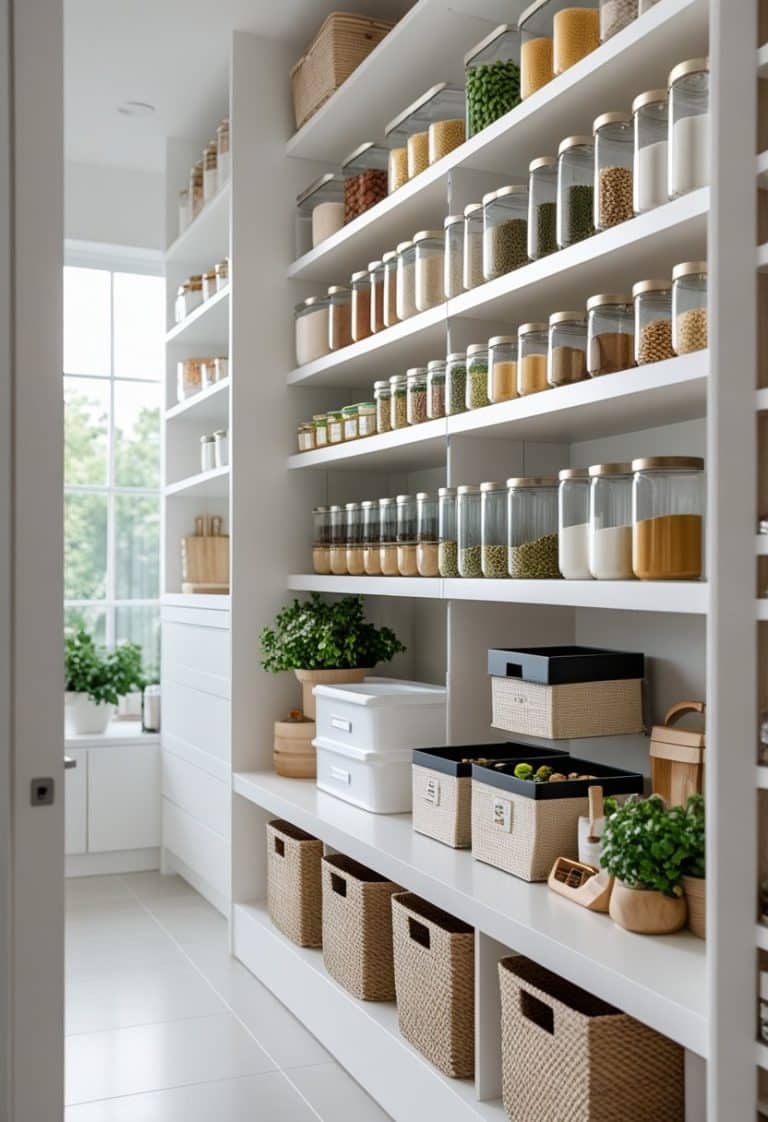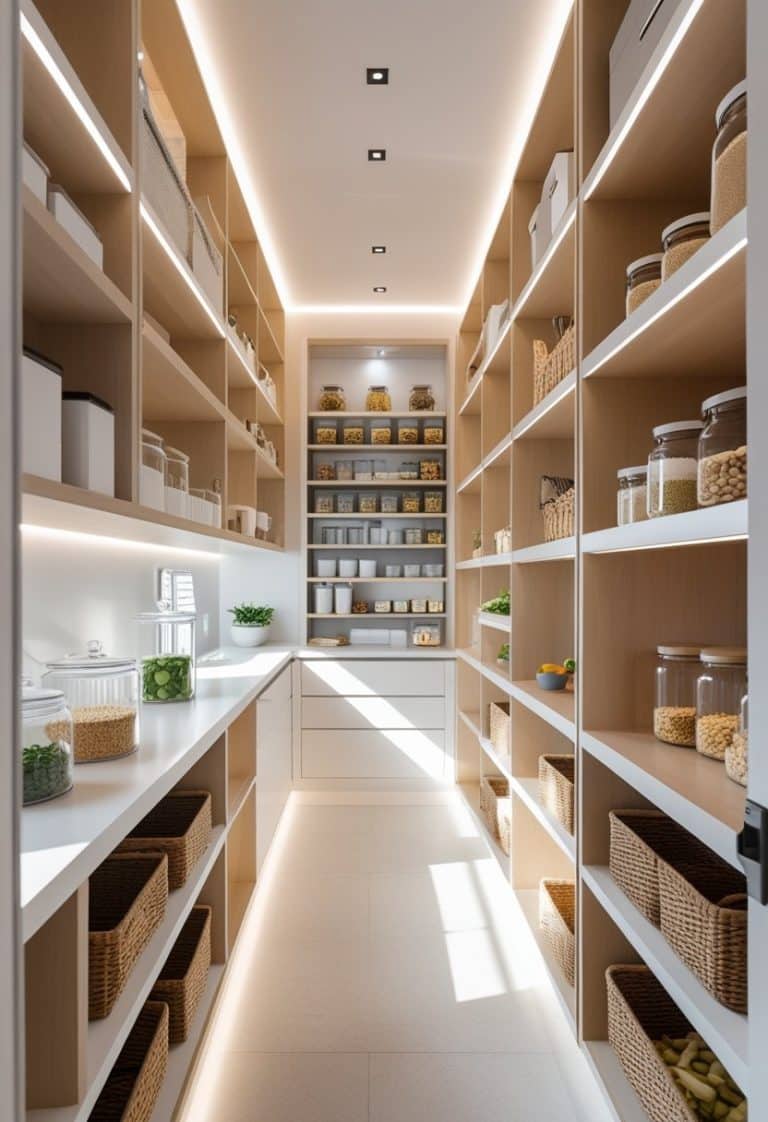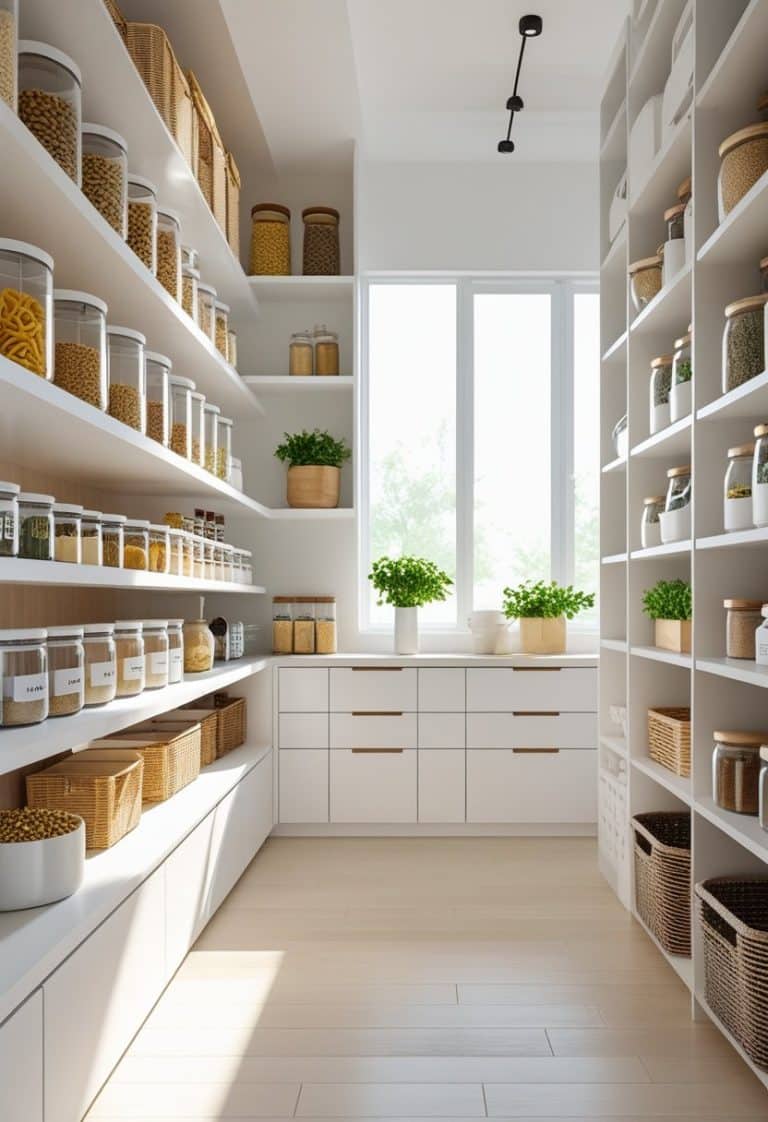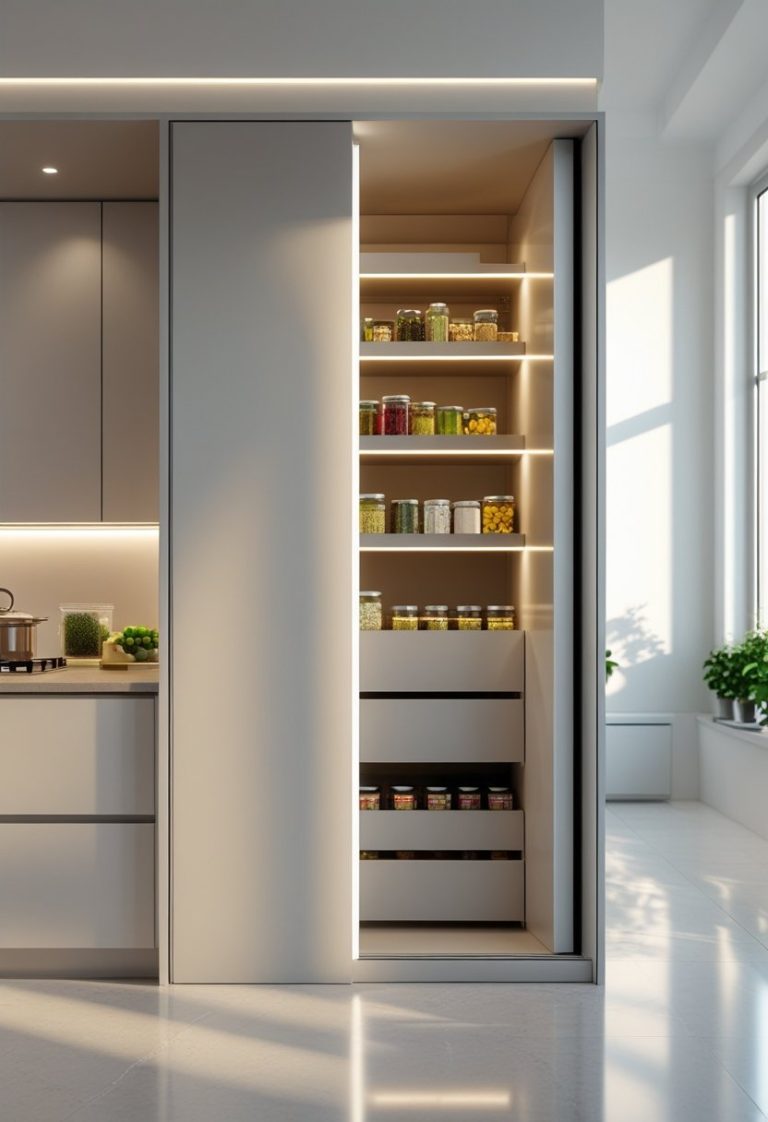Small Pantry Ideas 2026: 22 Smart Ways To Maximize Storage Space

Small pantry design continues to evolve in 2026, focusing on practical organization and efficient use of limited space. Homeowners look for ways to make compact kitchens more functional without sacrificing style. A well-planned pantry helps maximize storage, reduce clutter, and create a smoother cooking experience.

This article explores simple ways to improve pantry organization through shelving, lighting, and smart storage tools. It highlights methods that make every inch count, from vertical stacking to labeling systems that keep supplies easy to find. Each section offers clear ideas to help transform small spaces into organized, modern storage areas.
Install adjustable shelving to customize storage height

Adjustable shelves let homeowners change the space between levels to fit different items.
They can raise a shelf to store tall bottles or lower it for small jars and cans.
This flexibility helps them use every inch of the pantry and keep supplies easy to reach.
Use clear airtight containers for dry goods

Clear airtight containers help keep dry goods fresh by blocking air and moisture.
They make it easy to see what is inside, reducing waste and overbuying.
Stackable designs save space, which is especially useful in small pantries.
Add a rolling ladder for easy access to high shelves

A rolling ladder helps reach upper pantry shelves without using a bulky step stool.
It attaches to a track that allows smooth movement along the wall.
Many kits include wheels, mounting hardware, and rails, making them simple to install in small spaces.
Mount door organizers for spices and small items

Mounting organizers on the inside of pantry doors helps use space that often goes unused.
They can hold spice jars, small bottles, or packets, keeping shelves less crowded.
Adjustable racks or adhesive shelves make installation simple and work well for renters or small kitchens.
Create zones for snacks, baking, and canned goods

They can make a small pantry more efficient by grouping similar items together.
Snacks go on lower shelves for easy access, while baking supplies fit well in clear, labeled containers.
Canned goods stack neatly by type, making it simple to find ingredients and track what needs restocking.
Utilize vertical space with stackable bins

Stackable bins help make the most of limited pantry space. They let items be stored upward instead of outward, keeping shelves tidy and easy to access.
Clear bins allow quick visibility of contents, reducing time spent searching. Labeling each bin by category also helps maintain order and efficiency.
Label all containers for quick identification

They label each container to find ingredients faster and keep the pantry neat. Clear, simple labels help everyone know what’s inside without opening lids.
Printable or chalkboard labels work well for dry goods, snacks, and spices. Consistent labeling also makes restocking easier and prevents food from being forgotten.
Incorporate pull-out baskets for easy reach

Pull-out baskets help make small pantries more accessible and organized. They slide out smoothly, allowing users to see and reach items stored in the back.
These baskets work well for snacks, canned goods, or cleaning supplies. They also fit neatly into narrow cabinets, making the most of limited space.
Use tension rods to hang spray bottles or wraps

They can place a tension rod under the sink or across a pantry shelf to hang spray bottles by their nozzles.
Another rod can hold rolls of plastic wrap, foil, or parchment paper for easy access.
This setup keeps supplies organized and frees up shelf or cabinet space.
Add under-shelf baskets for additional storage

Under-shelf baskets create extra space by attaching beneath existing shelves. They help store small items like tea bags, seasoning packets, or wraps.
This simple addition uses space that often goes unused. It keeps the pantry organized and makes frequently used items easier to reach.
Install magnetic strips for metal tools or lids

They can attach magnetic strips to the inside of pantry doors or walls to hold metal lids, measuring spoons, or small tools.
This setup keeps items visible and easy to grab without taking up shelf space.
Strong adhesive or screws help secure the strip for reliable use.
Use lazy Susans for corner shelves

Lazy Susans help make corner shelves easier to reach. They rotate smoothly, allowing quick access to items stored in the back.
They work well for spices, condiments, and small pantry goods. Using tiered versions can also increase storage space without cluttering the shelves.
Place a chalkboard or whiteboard for inventory lists

A chalkboard or whiteboard inside the pantry door helps track what items run low.
It keeps grocery lists and meal plans visible, reducing duplicate purchases.
They can quickly update the board after using ingredients, keeping inventory accurate and organized.
Incorporate wire racks for better airflow

Wire racks help air move around stored items, keeping food dry and easy to see.
They work well in small pantries because they prevent moisture buildup and make cleaning simple.
Their open design also allows better light flow, which helps people find what they need faster.
Use tiered shelf organizers for cans

Tiered shelf organizers help keep canned goods visible and easy to reach.
They let users see labels at a glance instead of digging through stacks.
This setup works well for deep shelves, making the most of limited pantry space while keeping items neat and accessible.
Add a pegboard for hanging utensils or baskets

A pegboard helps keep small pantry spaces organized and tidy.
They can hang utensils, small baskets, or measuring cups to free up drawer and shelf space.
Metal or painted wood pegboards hold up well in kitchens and can be customized with hooks, shelves, or containers for easy access.
Store bulk items in large clear containers

They can keep bulk items like rice, pasta, and flour in large clear containers to save space and reduce clutter.
Clear containers make it easy to see what’s inside and when supplies run low.
Airtight lids help maintain freshness and prevent pests or moisture from getting in.
Use drawer dividers for small packets and seasoning

Drawer dividers help separate small pantry items like seasoning packets, tea bags, and snacks.
They keep drawers neat and prevent items from mixing together.
Clear or bamboo dividers make it easy to see what’s inside and fit different drawer sizes for flexible organization.
Install LED strip lights for better visibility

LED strip lights help brighten dark pantry shelves and corners. They provide even light across surfaces, making it easier to find stored items.
These lights fit along edges, under shelves, or around the door frame without taking up space. Motion-sensor or plug-in options suit different layouts and budgets.
Hang a peg rail for frequently used items

A peg rail helps keep everyday items within reach. It works well for hanging aprons, measuring cups, or small baskets.
Installing one along a pantry wall or door uses vertical space efficiently. They can choose wood or metal rails to match the pantry’s style while keeping surfaces clear.
Use stackable clear bins for produce

Stackable clear bins help keep fruits and vegetables visible and easy to reach.
They let users see what they have, reducing waste and saving time during meal prep.
These bins fit neatly on shelves, making small pantry spaces more efficient and organized.
Add a small countertop for sorting and organizing

A small countertop inside the pantry gives space to sort groceries or prepare ingredients. It helps keep the kitchen counters clear and organized.
They can use it to unpack bags, label containers, or set small appliances. Durable materials like laminate or wood make cleaning simple and maintenance easy.
Maximizing Vertical Space

Using vertical space helps store more items without expanding the pantry’s footprint. Adjustable shelves and door-mounted organizers make it easier to fit containers, cans, and small appliances efficiently.
Utilizing Adjustable Shelving
Adjustable shelving allows homeowners to customize shelf height to match the size of their pantry items. This flexibility helps reduce wasted space between shelves and keeps frequently used goods within easy reach.
They can install metal tracks or pre-drilled peg systems that let shelves move up or down as storage needs change. For example, tall shelves can hold cereal boxes, while shorter gaps can fit jars or spice containers.
A simple way to plan shelf placement is to group items by height and frequency of use:
| Item Type | Ideal Shelf Height | Notes |
|---|---|---|
| Spices & Jars | 6–8 inches | Keep at eye level |
| Canned Goods | 8–10 inches | Stackable for easy access |
| Bulk Containers | 12–15 inches | Place on lower shelves |
Using clear bins or pull-out drawers on adjustable shelves also helps maintain order and visibility. This system works well in both small closets and walk-in pantries.
Incorporating Over-the-Door Organizers
Over-the-door organizers take advantage of unused vertical space behind the pantry door. They can store lightweight items such as spices, snacks, wraps, or cleaning supplies.
Many models include wire racks, pockets, or clip-on baskets that attach securely to standard doors. Adjustable hooks allow the organizer to fit different door thicknesses without drilling holes.
To keep the setup efficient, homeowners can sort items by category:
- Top racks: spices, condiments
- Middle racks: snacks, baking supplies
- Lower racks: wraps, foils, and cleaning items
This setup keeps small items visible and easy to grab, freeing up shelf space for larger containers and appliances.
Smart Storage Solutions

A small pantry works best when every inch of space serves a purpose. Using stackable containers and clear labeling helps keep food visible, accessible, and fresh while reducing clutter.
Choosing Space-Saving Containers
Selecting the right containers makes a major difference in how efficiently a pantry functions. Square or rectangular containers fit neatly on shelves and waste less space than round ones. Clear plastic or glass options let users see contents quickly, reducing duplicate purchases.
A good approach is to group containers by food type. For example:
| Category | Recommended Container Type | Notes |
|---|---|---|
| Dry goods (rice, pasta) | Airtight plastic bins | Keeps food fresh longer |
| Snacks | Stackable boxes | Easy to grab and restock |
| Baking supplies | Glass jars | Prevents moisture buildup |
Adjustable shelf inserts or pull-out baskets can also help make use of vertical space. Using uniform container sizes allows for tight stacking and a cleaner appearance.
Labeling and Categorization Strategies
Clear labeling helps maintain order and saves time when cooking or restocking. Labels should include the item name and expiration date. A simple label maker or adhesive tags work well for most containers.
Grouping similar items together improves efficiency. For instance, baking ingredients can stay on one shelf, while canned goods occupy another. Color-coded labels can help families identify categories quickly.
A short list of labeling tips:
- Use waterproof labels for easy cleaning.
- Keep font size large and readable.
- Place labels on the front, not the lid, for quick viewing.
Consistent labeling and thoughtful categorization make even the smallest pantry look organized and easy to maintain.




